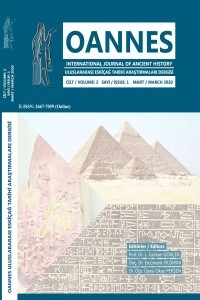
OANNES - Uluslararası Eskiçağ Tarihi Araştırmaları Dergisi
Yazarlar: Ekrem MEMİŞ
Konular:Tarih
Anahtar Kelimeler:Justice Comprehension,Laws,Legislators,Mesopotamia,Anatolia
Özet: The institution of justice is one of the institutions that human communities need most from the early years of history. In societies that have not yet reached the state stage, the distribution of justice has been carried out through boards consisting of the leading people of that society. As it turns out, the distribution of justice was carried out on the basis of non-written customs rules in the early periods when the writing was not invented yet, while the unwritten legal rules were written about 8 centuries after the discovery of the writing. These laws are written on clay tablet sor steles. It is seen that a significant part of the Legislators in the Ancient Near East are kings. Kings often stated that they obtained the authority to govern and make laws and enforce these laws from the gods in the documents they have printed. For example in Mesopotamia which is one of the important civilization centers of Ancient Near East, the vast majority of legislators or the writers of the legal documents are the kings who also have authority to govern. Urukagina, the king of Lagash; Ur-Nammu, the founder of the Third Ur Dynasty; Lipit-Ishtar, the king of Isin; Hammurabi, the famous king of the Old Babylonian are the firsts to come to our minds. The desire to seek rights and justice, which began among Mesopotamian societies, began to Show itself in other centers of the Ancient Near East over time. While the understanding of justice of the Jewish community in the Old Testament is revealed in all its details, it is understood by the articles of law that there is an advanced understanding of justice in the Hittites, who were accepted as the dominant power of Anatolia in the Second Millenium BC. In this study, we will try to reveal how the understanding of rights and justice emerged in the Ancient Near East, why the unwritten rules were written and to what extend they applied them, based on written sources.